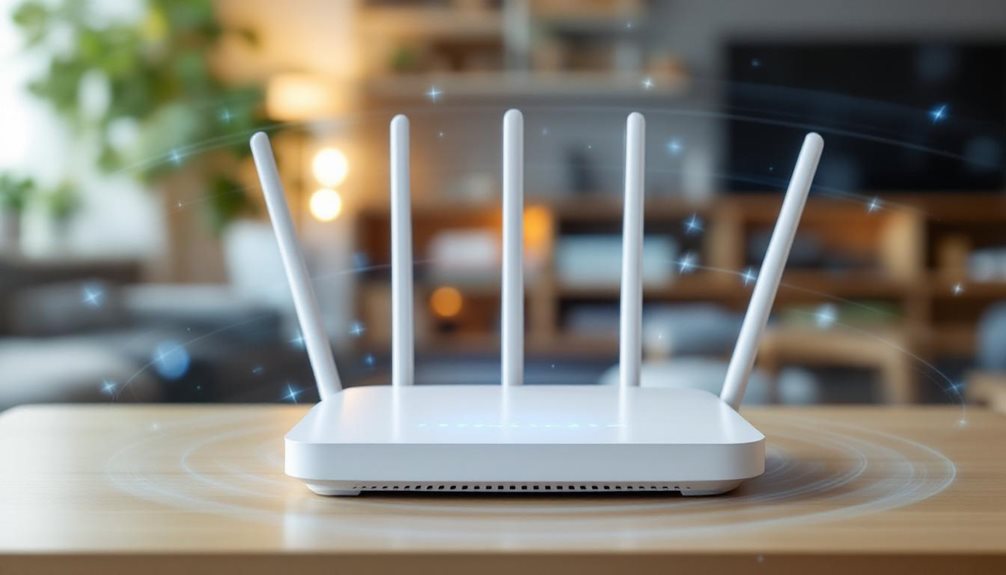Wireless internet works by converting data into binary code that travels through electromagnetic waves broadcast from aerials. These radio signals spread outward spherically, connecting devices without physical cables.
Routers and access points act as bridges between wireless devices and wired networks, managing traffic flow and assigning IP addresses. Unlike traditional broadband‘s consistent cable-based speeds, wireless signals can vary based on distance and obstacles. Comprehending these components reveals why wireless technology has become essential for modern connectivity.
What Makes Wireless Internet Different From Traditional Broadband
When someone compares wireless internet to traditional broadband, they’re looking at two fundamentally different approaches to getting online. The biggest difference? Physical connections.
Broadband relies on actual cables—fibre optic, ADSL, or coaxial—running straight to homes and businesses. Wireless, on the other hand, broadcasts signals through the air using radio frequencies, similar to how mobile phones work.
Broadband needs physical cables while wireless sends signals through the air like mobile phones
This fundamental split affects everything else. Broadband delivers consistent speeds regardless of weather or how many neighbours are online. Though wireless broadband like 4G and 5G can provide mobile internet access, they typically experience more variability than fixed connections. Wireless speeds fluctuate based on distance from towers and physical obstacles like buildings or trees.
Security also differs considerably. Breaking into a broadband connection requires physical access to cables, while wireless signals travel freely through the air, making encryption absolutely essential. Fibre optic connections offer symmetrical speeds with equal upload and download rates, a feature wireless broadband struggles to match consistently.
Geographic coverage represents another key distinction, with wireless options serving as an ideal solution for rural areas where laying physical cables proves challenging or cost-prohibitive. Many providers offer uncapped broadband plans to ensure users don’t face data limitations regardless of their connection type.
The Science Behind Wireless Signal Transmission
Comprehending how wireless signals actually work requires looking at the invisible forces that make modern connectivity possible.
When devices send data, they convert information into binary code—just zeros and ones. These digital signals change into electromagnetic waves through antenna oscillations, spreading outward like ripples in a dam.
Key principles governing wireless transmission include:
- Frequency encoding: Data rides on specific radio frequencies (2.4 GHz or 5 GHz bands)
- Wave propagation: Signals travel spherically in all directions from the antenna
- Material interaction: Walls and objects cause refraction, reflection, and absorption
- Channel management: Multiple channels prevent signal interference between devices
- Power efficiency: Modern Wi-Fi transmits in short bursts, using minimal energy
Advanced routers employ QAM technology to transmit multiple data streams simultaneously by modulating both amplitude and phase of radio waves. When signal strength drops, devices automatically switch to simpler modulation schemes, reducing speed but maintaining connection stability. This electromagnetic dance happens millions of times per second, creating the seamless internet experience users expect across South Africa’s diverse landscapes and building structures.
Essential Components That Power Your Wireless Connection
Whilst invisible electromagnetic waves carry data through the air, the physical components behind wireless internet networks form the backbone that makes modern connectivity possible. Think of these devices as the unsung heroes working behind the scenes.
Access points act like digital bridges, connecting your smartphone to the wired network infrastructure. Meanwhile, routers manage traffic like air traffic controllers, ensuring data packets reach their destinations efficiently. Wireless controllers serve as the central command centre, managing multiple access points simultaneously to optimise performance and security across the entire network.
Here’s how key components work together:
| Component | Primary Function |
|---|---|
| Access Points | Bridge wireless devices to wired networks |
| Routers | Direct traffic and assign IP addresses |
| Network Switches | Enhance data flow between devices |
Without these physical components, those electromagnetic waves would be like radio stations broadcasting to nobody—plenty of signal, but no way to receive or process it.
Why Wireless Broadband Excels in Underserved Areas
Rural communities across South Africa face a connectivity crisis that traditional infrastructure can’t solve cost-effectively, but wireless broadband technology offers a practical lifeline. Unlike fibre-optic cables that require massive investment to lay across vast distances, wireless systems beam signals through the air, slashing implementation expenses dramatically.
This flexibility proves essential for regions where traditional providers won’t invest.
The advantages become clear when examining real-world impacts:
- Economic transformation: Provinces with strong broadband see significantly more business openings
- Healthcare revolution: Telemedicine connects rural patients to urban specialists instantly
- Educational equality: Students access online courses without leaving their communities
- Job creation: Remote work opportunities eliminate the need to relocate to major centres
- Environmental benefits: Smart farming technologies boost agricultural productivity whilst reducing carbon footprints
For businesses operating across multiple locations in these areas, VPN services can provide secure connectivity solutions that integrate seamlessly with wireless broadband infrastructure to enable safe inter-branch communications and remote access capabilities.
Providers that offer rural coverage alongside urban services ensure comprehensive connectivity solutions that bridge the digital divide across diverse geographical landscapes.
Wireless broadband isn’t just technology—it’s economic justice for underserved South Africans.
